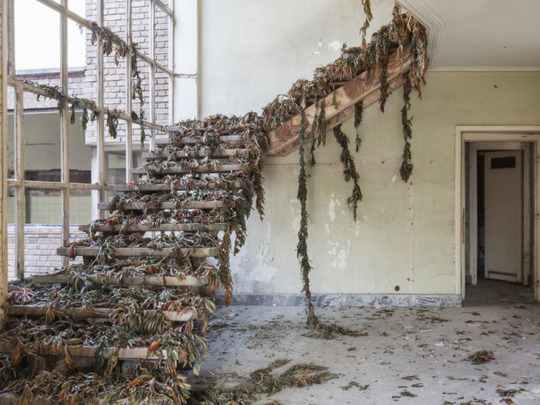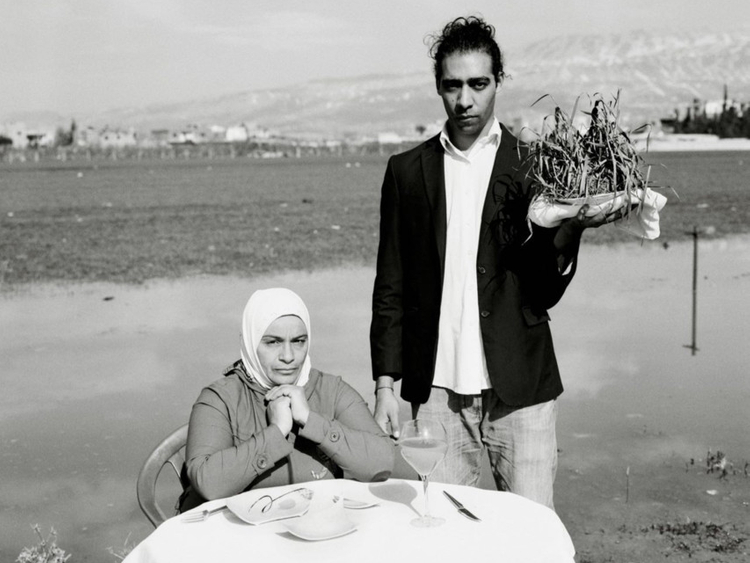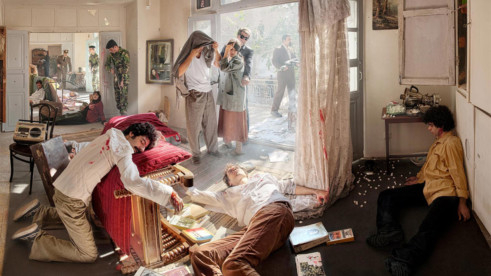
When she was a little girl, Iranian photographer Gohar Dashti lived in the border town of Ahwaz during the Iran-Iraq War of the 1980s when every day was filled with the sound of falling bombs. But once the onslaught stopped, she and her friends would pick up the bullets which landed in her family’s house. It was a game. It was fun.
Violence, oppression, censorship, these are the preoccupations expected from photographers from the Middle East. But fun? Dark humour? These are the unexpected qualities reflected at Photo London where a record number of photographers from the region are exhibiting their works.
It is no surprise to see the gruelling images of the destruction of Syria — damaged streets, grieving mothers and fathers — captured by Hosam Katan who was born in Aleppo and began his career in 2015 by using his mobile phone to record the Syrian police firing at crowds of protestors.
He was shot in the stomach but continued to work until he joined the flow of migrants fleeing his strife-torn country to Germany where he now works for Reuters. He has produced a book, Yalla Habibi about life under siege in eastern Aleppo. He told the New York Times: “My experience in the past years changed the way I think, live and dream. I know now that life is about more than the basic needs of food and shelter. It is about ambition, and photo-journalism is my ambition.”
Most of the contributors to Photo London share Katan’s passion to offer their version of the dangerous world they inhabit but some are altogether more nuanced and more subtle because they avoid the horror of it all, more surprising than his uncompromising reportage.
Perhaps that is only to be expected with such a range of photographers from a swathe of what one can loosely call the Middle East — Iran, Azerbaijan, Israel, Syria, Jordan, Turkey — and given an international prominence by the galleries which represent them from Italy, Turkey, London, Dubai and New York.
It is unwise to make generalisations about their work but as Fariba Farshad, co-founder of Photo London, says: “If they have one thing in common, it is staging. For example, in Iran after the Green Movement of 2009 which was a mass protest against the election of Mahmoud Ahmadinejad as president, the leaders were arrested and jailed. Anyone carrying a camera was suppressed. Photographers started to stage their works so that they could express themselves more freely. They started documenting lives in a way that would not be censored. They created a lot of murmur around their images without actually telling the story itself. People can look and see and make up own minds without getting into trouble.”
Gohar Dashti made her reputation by arranging improbable scenes in the unrelentingly bleak countryside of Iran. Boys in underpants standing in a bath, a couple sitting in the burnt-out skeleton of a car and more sinister, a couple calmly having tea with a tank’s gun pointing at them.
“I was studying in Tehran and every other week, I would visit my family 1,000 kilometres away and I realised looking at the country from the train or the car that there is nothing there. It’s a very big country but you cannot live everywhere because it doesn’t have water and much of it is empty. Society is like that. You can have a lot of opportunities to live but you may not be able to take them. In the photos the people have a lot of space around them but they are limited to the one space they are in. There is not enough room for us to live emotionally so for me there is a connection between geography and society,” says Dashti.
The two series of images she is showing at Photo London indicate a new direction. One, entitled Home, is a disturbing staging of plants, creepers and weeds in deserted houses.
“Two years ago, I went back to my hometown do some research about water and pollution because Ahwaz is one of the most polluted cities in the world. A family of poor people were living in my old house and it had been neglected but a palm was still growing in the courtyard as it had when I lived there. Many homes had been abandoned so I put flowers and plants in them. It says, we go but nature stays, even after many years, long after we have gone. It’s like nature has more power than humans. It is a fantasy but if I did not have fantasy in my life I could not continue,” she says.
As one critic put it: “A jungle of ferns flourishing in an abandoned home is more jarring to our desensitised media-glutted gaze than a snarl of bodies in barbed wire, an enumeration of the casualties, so-called collateral damage.”
At first glance, Dashti’s other series, Still Life, looks like a set of pretty, swirling images made by using techniques originated by Anna Atkins, the 19th century English botanist who created photographs on paper treated with salt and a solution of silver nitrate. But appearances are deceptive.
“The concept is much more abstract,” says Dashti. “In Still Life, you can find the social and cultural issues that influence my life. Unlike Anna Atkins who used the plants very sensitively, I destroy them before I put them under the paper. I break them up. For me it is a concept of how humans destroy nature. It is like I killed someone. I remember when I was a child, I had a dream that someone in the house was killed by a bomb. When a bomb hits, you try to find where you have been injured by reaching for your hand or your head. Still Life is like that. When I destroy the plant and put it under paper it’s like the hand being put under the paper.
“I make a kind of beauty but it’s like perfume, you destroy nature and make a perfume out of it,” Dashti says.
Omar Imam who left Damascus in 2012 is another photographer who sets up scenes to depict the plight of Syrian refugees but instead of capturing the despair in ugly images, he combines pathos with wit.
In his series Live, Love, Refugee the Amsterdam-based photographer asked refugees to recreate their dreams, whether they were of hope or death, love or fear. In what he calls humanitarian surrealism, his images include a refugee sitting at a table in the empty countryside being served a meal with mock formality. The meal is a plate of grass. The woman later suffers from anorexia. In another, with painful poignancy, a Charlie Chaplin-esque character tells his blind wife stories from the TV series she cannot enjoy in a refugee camp and, oddly, a couple stand under an umbrella in a cardboard box.
Perhaps no one stages her work more elaborately and with greater precision than Iranian Azadeh Akhlaghi. In her series By An Eye-Witness, she has reconstructed 17 controversial deaths from the country’s recent history.
They are cinematographic, as one might expect from someone who worked in film for many years but frozen in time, as these tableaux are, they become chilling testimonies to the corruption, cover ups and unlawful killings that have besmirched the country’s various revolutionary movements.
Ahklaghi, who often puts herself in the picture as a woman in a red headscarf and black dress, takes a copy of Goya’s The Third of May to depict a leftist intellectual being gunned down by firing squad in 1975.
A controversial poet who upset the authorities with her outspoken feminism, swerved her car to avoid hitting schoolchildren, then crashed into a stone wall and died on impact. We are not spared the sight of her bloodied corpse as people rush to help. There is something Biblical about the mourners gathered around the dead body of a communist intellectual who died in prison, his face and body unrecognisable because of the torture he suffered. His own mother could not identify him.
Tanya Habjouqa, who lives in East Jerusalem, also looks for subtle means of investigating suffering and loss in Palestine.
She says: “I really felt like I needed to find another way to tell a story, not only just to make sense of it for myself but to make sense of it for how I’m going to present it to my children as well, since this is going to be their home too.”
The result is photographs of girls throwing the javelin, weight-lifters showing off their pecs, furniture makers taking a break in a pair of plush armchairs they have made in scrubby land but set with Israel’s separation barrier as the background.
Beirut born and based Serge Najjar has also experienced war but it took him in a different direction.
“I had a love-have relationship with art until the war started in the region and I had to hide in the shelters,” he says. “I didn’t know what to do. There was no school, nothing to do, no friends, nobody, so I just started looking at all the auction catalogues which my father had collected. I started to understand the passion my father had towards art. I’m a very bad painter and I was really convinced that I would never create anything artistically but I started taking pictures which looked a bit like all those paintings my eye had learnt to understand because at the time one’s eye starts to understand the composition.”
For him the stage is ready made. His work is inspired by the architecture he sees around him in Beirut and would be at home in the current Tate Modern exhibition Shape of Light: 100 years of Photography and Abstract Art which argues that photographers can create abstraction as well as a painter.
“The capital is a beautiful, modern metropolis with contemporary architecture and tall skyscrapers, bursting with colour and gleaming in the sunlight,” he says and that is what he reflects with images which are all shadows and angular shapes, mostly in black and white.
His primary influences is the Russian painter Kazimir Malevich who used bold geometric shapes and stark colours, such as his challenging Black Square.
“I studied Fauvism, cubism, geometric abstraction and on to optical art. I was interested in constructivism and the Russian avant garde,” says Najjar. “I did not know those artists and when I started and I did not understand what photographers were trying to do but I forced myself to be interested.”
How does he work?
“I started taking pictures with my iphone. In fact I was only given a camera for the first time in 2011. I take my car and try to spot things. I never know the people I photograph, never. I can get to a construction site and wander around for half a day trying to take pictures and come back with no picture. It’s never planned. Sometimes they might think I am a spy and taking pictures for other purposes. Never knowing what I will find is an adrenaline boost. It is essential for me. It keeps my passion intact.
The titles of two recent series Architecture of Light and Lines of Light sum up his distinctive style.
Non Objective View was taken in a classroom with a balcony overlooking the sea. The influence of Russian constructivism is clear, the black of the walls, the blue square of a building opposite and an awkward patch of light which does not seem related to its surroundings.
“It felt right when I took it,” he says. “It is exactly how I choose pictures. They must be related to my feelings and directly to the composition. There was no waiting for the right moment, no waiting for anyone to be in the picture. The tension would be ruined by a person. I just look at it and think this is the picture I should take. That is why I don’t talk about the situation here in Lebanon because the situation is not a subject for me,” Najjar says.
“While others talk about war, I would rather talk about positive things. I don’t think about photography today as if it has to have a certain aim. It’s not my way because my work is not based on anything other than an aesthetic approach based on the culture I grew up with. I want to show people what they won’t see by themselves; to realise there is art everywhere even in places like Lebanon, torn by war for many years. People should concentrate at looking at even things that are considered as ugly with less judgement and more creativity,” he says.
Richard Holledge is a writer based in London.
The fourth edition of Photo London is on at the Somerset House until May 20.














